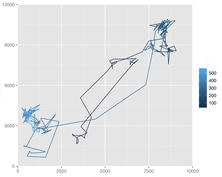Publication trimestrielle du Laboratoire
d'analyse et d'architecture des systèmes du CNRS
Proteins are biological macromolecules that play essential roles in living organisms. Understanding the relationship between protein structure, dynamics and function is indispensable for advances in fields such as biology, pharmacology and biotechnology. Studying this relationship requires a combination of experimental and computational methods, whose development is the object of very active interdisciplinary research. In such a context, this thesis presents a robotics-inspired modeling approach for studying conformational changes in proteins. This approach is based on a mechanistic representation of proteins that enables the application of efficient methods originating from the field of robotics. It also provides an accurate method for coarse-grained treatment of proteins without loosing full-atom details.The presented approach is applied in this thesis to two different molecular simulation problems. First, the approach is used to enhance sampling of the conformational space of proteins using the Monte Carlo method. The modeling approach is used to implement new and known Monte Carlo trial move classes as well as a mixed sampling strategy. Results of simulations performed on proteins with different topologies show that this strategy enhances sampling without demanding higher computational resources. In the second problem tackled in this thesis, the mechanistic modeling approach is used to implement a robotics-inspired method for simulating large amplitude motions in proteins. This method is based on the combination of the Rapidly-exploring Random Tree (RRT) algorithm with Normal Mode Analysis (NMA), which allows efficient exploration of the high dimensional conformational spaces of proteins. Results of simulations performed on ten different proteins of different sizes and topologies show the effectiveness of the proposed method for studying conformational transitions.





